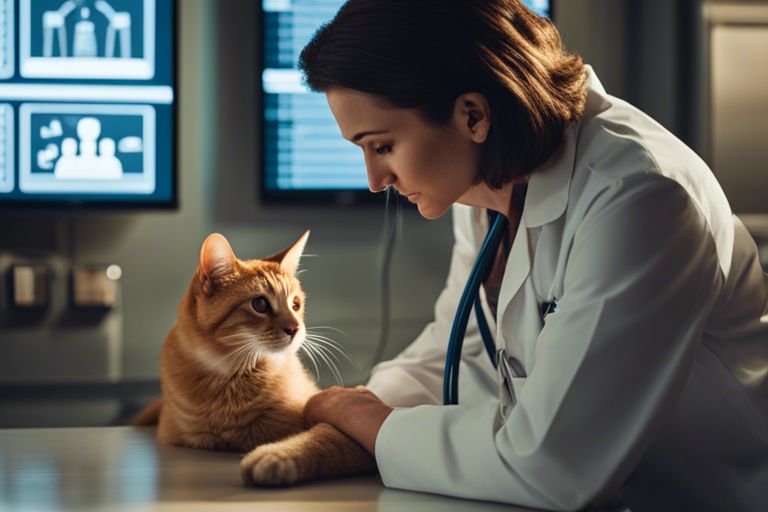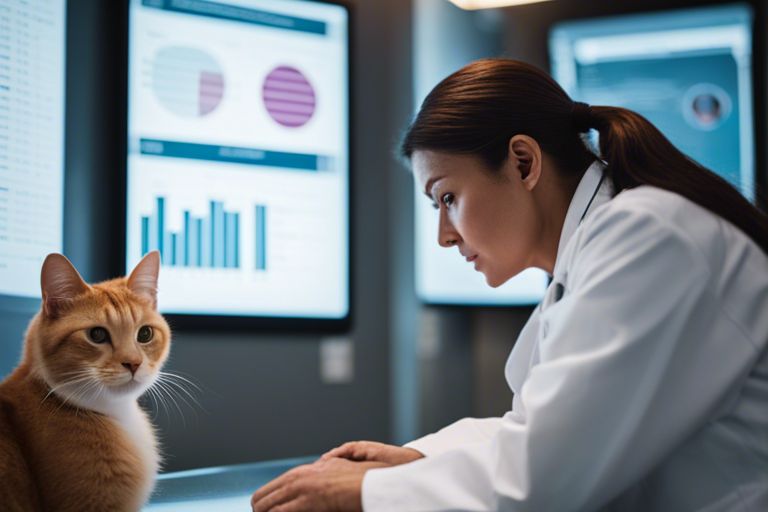Jaundice in cats is a condition that occurs when there is a buildup of bilirubin in the bloodstream, leading to yellowing of the skin, eyes, and mucous membranes. This can be caused by a number of underlying health issues, such as liver disease, infection, or an obstruction of the bile duct. If you notice yellowing of your cat’s skin or eyes, it is important to seek veterinary care immediately as untreated jaundice can lead to serious complications. Your veterinarian will perform a thorough physical exam and may recommend blood tests, ultrasounds, or biopsies to diagnose the underlying cause of jaundice. Treatment will vary depending on the specific issue, but may include medication, dietary changes, or surgical intervention to address the root cause of the condition. It is crucial to follow your veterinarian’s recommendations closely and monitor your cat’s progress to ensure the best possible outcome.
Key Takeaways:
- Causes of Jaundice: Jaundice in cats can be caused by a variety of factors, including liver disease, pancreatic issues, infections, or obstruction of the bile duct.
- Symptoms to Look For: Some common signs of jaundice in cats include yellowing of the skin and eyes, dark urine, pale gums, and a lack of appetite.
- Diagnostics and Treatment: To diagnose jaundice in cats, a veterinarian may conduct blood tests, ultrasound, or other imaging studies. Treatment may involve addressing the underlying cause, medications, and supportive care such as IV fluids and nutritional support.
- Preventative Measures: Preventing jaundice in cats may involve maintaining a healthy diet, regular veterinary check-ups, and avoiding exposure to toxins or infectious agents.
- Importance of Veterinary Care: If you suspect your cat has jaundice, it’s important to seek veterinary care promptly. A veterinarian can provide an accurate diagnosis and develop a tailored treatment plan for your cat’s specific needs.
Understanding Jaundice
Some cats may develop jaundice, a condition characterized by yellowing of the skin, gums, and whites of the eyes. Jaundice in cats can be indicative of underlying health issues and should be promptly addressed by a veterinarian.
Definition and Pathophysiology
Jaundice in cats, also known as icterus, occurs when there is an excessive accumulation of bilirubin in the bloodstream. Bilirubin is a yellow pigment produced during the normal breakdown of red blood cells. When the liver is unable to process and excrete bilirubin effectively, it can build up in the body, leading to the characteristic yellow discoloration of the tissues.
Types of Jaundice in Cats
There are several types of jaundice that can affect cats, including pre-hepatic, hepatic, and post-hepatic. Pre-hepatic jaundice occurs when there is excess bilirubin production, as seen in conditions such as hemolytic anemia. Hepatic jaundice is caused by liver disease or dysfunction, while post-hepatic jaundice results from obstruction of the bile ducts. This can occur due to conditions such as gallstones or tumors. This can impact your cat’s overall health and require immediate medical attention.
| Type of Jaundice | Cause |
|---|---|
| Pre-hepatic | Excess bilirubin production, as seen in conditions like hemolytic anemia |
| Hepatic | Liver disease or dysfunction |
| Post-hepatic | Obstruction of the bile ducts, such as gallstones or tumors |
Causes of Jaundice in Cats
Obviously, jaundice in cats can be a troubling sign, and it’s important to understand the underlying causes. If you want to read more about this, you can check out this informative article on Jaundice in Cats. There are a variety of reasons why your feline friend may develop jaundice.
Prehepatic Causes
One of the potential prehepatic causes of jaundice in cats is hemolysis, which is the breakdown of red blood cells. This can occur due to certain infections or immune-mediated diseases. Additionally, ingestion of certain toxins, such as onions or garlic, can also lead to hemolysis and jaundice in cats.
Hepatic Causes
When it comes to hepatic causes of jaundice in cats, liver disease is often the culprit. This can be the result of conditions such as hepatitis or cirrhosis, or even cancerous growths within the liver. These can all impair the liver’s ability to process and excrete bilirubin, leading to jaundice.
Posthepatic Causes
If there are obstructions in your cat’s bile ducts, it can lead to jaundice as well. This might be caused by the presence of gallstones or tumors that are blocking the flow of bile. These obstructions prevent bilirubin from leaving the liver and entering the intestines, resulting in its accumulation in the bloodstream and eventually leading to jaundice.
Remember, if you notice any signs of jaundice in your cat, it’s crucial to seek veterinary care immediately. Jaundice can be a sign of serious underlying health issues, and prompt diagnosis and treatment are essential for your cat’s well-being.

Diagnosing Jaundice in Cats
After noticing symptoms of jaundice in your cat, it is important to take your pet to a veterinarian for a proper diagnosis. Diagnosing jaundice in cats involves a thorough clinical evaluation, as well as laboratory tests and imaging.
Clinical Signs and Physical Examination
During the clinical evaluation, your veterinarian will look for yellowing of the skin, gums, and whites of the eyes, which are classic signs of jaundice. They will also examine your cat for any signs of liver or gallbladder disease, as well as any underlying conditions that could be causing the jaundice. Additionally, your veterinarian will take note of any other abnormalities in your cat’s behavior, appetite, and energy levels.
Laboratory Tests and Imaging
In order to confirm the diagnosis of jaundice and identify the underlying cause, your veterinarian will likely perform a series of blood tests to evaluate liver function and check for signs of infection or inflammation. They may also recommend imaging tests such as ultrasound or x-rays to visualize the liver and surrounding organs, and to look for any abnormalities or blockages that could be contributing to the jaundice.
Treatment Options for Jaundice
For cats suffering from jaundice, the treatment approach will depend on the underlying cause of the condition. It’s crucial that you work closely with your veterinarian to determine the most effective treatment plan for your cat’s specific situation. Treatment options for jaundice may include addressing underlying causes, providing supportive care and management, considering dietary considerations and nutritional support, surgical interventions if applicable, and understanding the prognosis and long-term care for your cat.
Addressing Underlying Causes
When treating jaundice in cats, it is essential to identify and address the underlying cause of the condition. Your veterinarian will conduct a thorough examination and may recommend additional diagnostic tests, such as blood work, imaging studies, or liver biopsies, to determine the root cause of your cat’s jaundice. Once the underlying cause has been identified, your veterinarian will develop a specific treatment plan to address the issue and alleviate the jaundice. Addressing the underlying cause is crucial for effectively treating jaundice and improving your cat’s overall health.
Supportive Care and Management
Supportive care and management are essential components of treating jaundice in cats. This may include providing fluids, medications to support liver function, and managing any symptoms or complications associated with the underlying cause of jaundice. Your veterinarian will work with you to develop a comprehensive care plan to help manage your cat’s condition and improve their overall well-being. Providing appropriate supportive care is crucial for helping your cat recover from jaundice and regain their health.
Dietary Considerations and Nutritional Support
Proper nutrition is vital for cats with jaundice, especially if the condition is related to liver disease. Your veterinarian may recommend a special diet tailored to your cat’s needs, including foods that are easy to digest and formulated to support liver health. Additionally, nutritional supplements or vitamins may be prescribed to ensure your cat receives essential nutrients during their recovery. Providing appropriate dietary considerations and nutritional support can aid in your cat’s recovery and help support their liver function.
Surgical Interventions (If Applicable)
In some cases, surgical interventions may be necessary to treat the underlying cause of jaundice in cats. This could involve procedures to address issues such as bile duct obstructions or tumors that are impacting liver function. Your veterinarian will discuss the potential need for surgical interventions and advise you on the best course of action for your cat’s specific situation. Surgical interventions, if applicable, can be crucial in resolving the underlying cause of jaundice and improving your cat’s prognosis.
Prognosis and Long-term Care
After beginning treatment for jaundice, it’s important to understand the prognosis and long-term care required for your cat. Your veterinarian will provide guidance on monitoring your cat’s condition, scheduling follow-up appointments, and managing any ongoing care needs. Understanding the long-term implications of your cat’s jaundice and any necessary lifestyle or dietary changes is crucial for their continued well-being. Being informed about the prognosis and long-term care for your cat is essential for providing them with the best possible quality of life.
Conclusion
On the whole, jaundice in cats can be caused by a variety of factors, including liver disease, gallstones, or anemia. Understanding the underlying cause of your cat’s jaundice is crucial in determining the most effective treatment method. Treatment for jaundice in cats often includes addressing the underlying condition, providing supportive care, and potentially implementing dietary changes. It’s important to work closely with your veterinarian to develop a treatment plan that specifically addresses your cat’s individual needs. Early detection and treatment of jaundice in cats is key to improving their overall health and well-being. Remember to always consult with a veterinary professional for tailored guidance and care for your feline companion.
FAQ
Q: What causes jaundice in cats?
A: Jaundice in cats can be caused by a variety of underlying issues, including liver disease, bile duct obstruction, pancreatitis, toxins, or anemia. It occurs when there is an excess of bilirubin in the bloodstream, which can be due to a breakdown of red blood cells, liver dysfunction, or blockage of the bile ducts.
Q: How is jaundice in cats treated?
A: Treatment for jaundice in cats depends on the underlying cause. In some cases, treatment may involve addressing the primary disease or condition, such as providing supportive care for liver disease, removing obstructions in the bile ducts, or managing anemia. Additionally, treatment may include addressing any potential underlying conditions, such as pancreatitis or toxins, and providing supportive care to help the cat recover.
Q: Is jaundice in cats a serious condition?
A: Jaundice in cats can be a serious condition and should be promptly evaluated and treated by a veterinarian. If left untreated, jaundice can lead to severe complications and even be life-threatening. It is important to seek veterinary care as soon as possible if you notice symptoms of jaundice in your cat, such as yellowing of the skin, gums, or eyes, inappetence, lethargy, or changes in behavior. Early detection and treatment can improve the prognosis for cats with jaundice.

Jayley, a devoted cat enthusiast, also writer for other cat blog as well. She aims to dedicated to providing comprehensive information, insights, and advice on everything you’d ever want to know about our whiskered companions.
